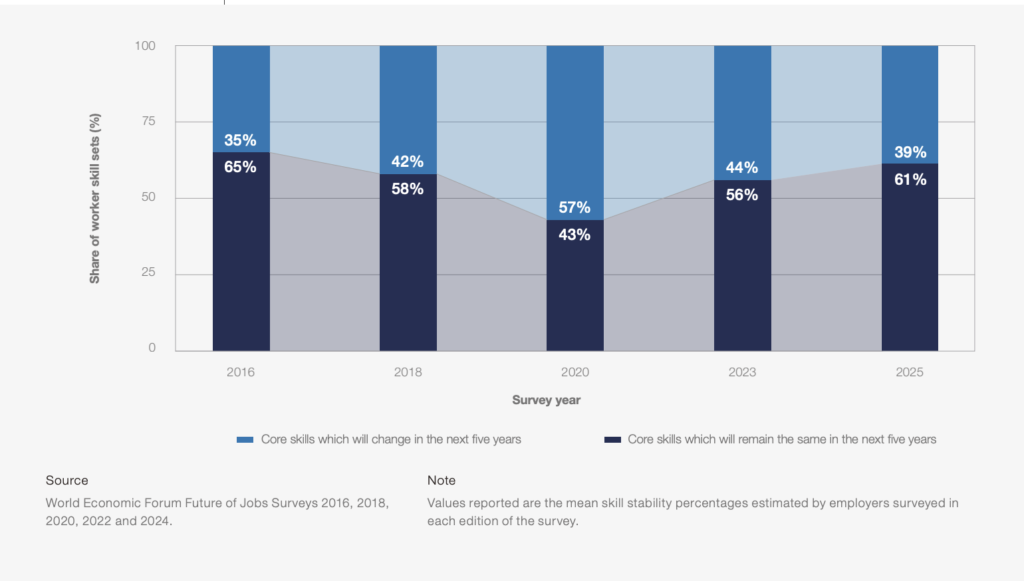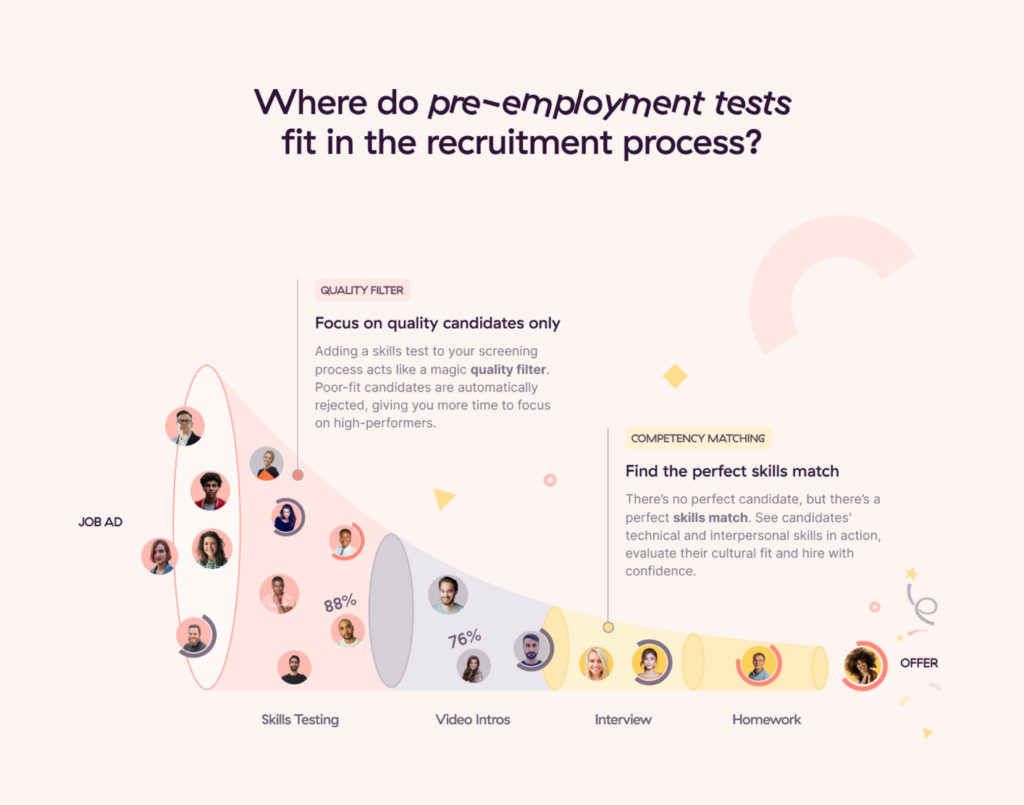If you’re slightly older, you still remember shopping as an in-store activity and DVD rentals as your gateway to new content. Today, you can get both online.
While this transition was smooth for us (as consumers), it was a big deal for businesses. In a few years, companies had to go online, build digital marketing teams, and implement advanced logistics robotics.
For every transformation, businesses need a ton of new skills, which are naturally in short supply. 63% of employers name ‘skills gaps’ as a major barrier to business transformation over the 2025-2030 period. And the term has been in the headlines for quite some time now.
So why are skills gaps persisting, and what can companies do to prepare their people for the future of work? Let’s find out.
TL;DR — Key Takeaways
- A skills gap is a mismatch between the competencies a role demands and an employee’s abilities. Skills gaps emerge when companies don’t invest enough in their people training or continuously struggle to attract the right talent.
- Almost every company struggles with skills gaps, especially as tech adoption picks up pace. Leaders most often report gaps in digital and technical skills. However, some workplaces also lack critical soft skills.
- To address skills gaps, companies need to create a taxonomy of existing competencies, using methods like skills assessments, 360-degree feedback, and behavioral interviews. Then use competency modeling to identify the key areas of development.
- Skills gaps often manifest as bigger company issues like low employee engagement or declining quality of work. Follow the trail of clues to size up the problem better.
- Aim to address gaps in hard (technical) and soft (interpersonal) skills. The former is faster and easier to train, while the latter has a higher long-term impact.
- Use metrics to evaluate the success of your training programs and measure your progress in addressing skills gaps. Provide continuous learning opportunities for your people to build a workplace culture of life-long learning.
Ready to close your company’s skills gaps?
Use our skills-first software to gain data-driven insights that help you hire smarter
See How It Works
What’s a skills gap (and what causes it)?
A skills gap is the difference between the hard and soft skills required for a job and the actual skills of your employees or potential hires. It means the person lacks the necessary competencies to succeed in their role.
Many of us were told that getting a “good degree” or “having a strong work ethic” is enough for a good 20-year career. But workforce skills evolve much faster now.
A marketing manager in the 2000s needed skills in traditional ad mediums like TV, print, and radio, an understanding of Nielsen ratings, and experience with in-person focus groups and observational consumer studies.
Today’s marketers need an entirely different competency set. They must have experience with programmatic advertising, MarTech platforms, big data analytics, social media, and online content production.
TLDR: New skills are required for almost every role, and businesses struggle to catch up.

Why do skills gaps persist?
The most common answer is “rapid technological advancements.” Apart from much-hyped AI, many other changes impact industries like healthcare, manufacturing, oil and gas.
LinkedIn data indicates a massive global demand for green skills like supply chain decarbonization, sustainable management, and environmental protection.
The World Economic Forum predicts accelerating demand for big data, cybersecurity, and technological literacy, while the WorkInHealth Foundation says European healthcare companies have limited access to STEM expertise, data analysis skills, and familiarity with regulatory environments.
But the truth is…neither the technologies nor the skills to support them have emerged overnight. While tech change exacerbates skills gaps, it isn’t the only factor.
Here are a few more reasons why global skills gaps persist:
- 📚Industry and education are out of step. Schools don’t update curriculums fast enough. While fundamental knowledge remains topical longer, hands-on hard skills and soft skills aren’t trained enough. Aussie employers believe that only 1% of tech graduates are “job-ready.” In the US, tech employers say new graduates need 12 months of training to become productive.
- 👷 Employee training is on the back burner. Skill-building is what many non-junior employees are expected to do in their own time (and on their own dime.) Companies prefer hiring new people with certifications over investing in training programs or expecting employees to “figure things out.” on their own. Less than a third of workers received new training and upskilling on GenAI tools last year (despite companies’ bullish adoption). Limited professional development opportunities reduce workforce competitiveness.
- ⚔️ Fierce talent competition. Companies need highly specialized skills — and candidates who have them often receive multiple job offers. This forces employers to increase pay and benefits for new hires. But not everyone can compete. 42% of Irish employees have missed out on hiring new talent due to salary and benefits competition. Those who do often have to “borrow” money from other buckets like L&D, which isn’t sustainable.
- ☄️ Corporate inertia. Finally, some companies are just slow to respond. Due to bloated org structures and poor comms processes, it takes months for HR teams to identify and escalate a skills issue to leadership, and then several more to get the green light to act. But companies that are ‘too comfortable’ with their operations are those first disrupted by a nimbler new entrant.
Examples of skills gaps in the workplace
Companies want competent employees but struggle to find them in the talent market. Reasons vary from a poor recruitment and candidate selection process to more structural problems with education program relevance or interest in specific specialties. Business leaders today most commonly report skills gaps in the following areas.
Digital skills
In the era of artificial intelligence and ubiquitous connectivity, you’d expect everyone to know how to do various digital tasks (like using online collaboration tools or file-sharing systems). Yet, only 48% of UK workers can complete all 20 essential digital workplace tasks like adjusting privacy settings or requesting an online payslip.
Interpersonal skills
Communication is essential for almost any role, but many graduates struggle with it. Brought up in the age of remote education and TikTok-style communication, young workers lack soft skills.
Almost half of executives said new hires lacked communication, collaboration, and adaptability skills. Many also lacked initiative and professionalism. Companies are responding with digital etiquette training and more formal “Business Power Skills” classes.
IT skills
Talent supply doesn’t match the corporates’ appetite for new technologies. 65% of tech managers see a skills gap within their departments, especially in AI, machine learning, data science, cybersecurity, technology process automation, and software development. Unfortunately, IT talent shortages will likely impact 9 in 10 companies by 2026.
What’s wrong with the traditional skills gap analysis and recruitment?
When trying to address skills gaps, employers often make two interlinked hiring mistakes:
☝️They want to attract “ready-made” candidates who tick all boxes but struggle to assess talent competencies during recruitment. By focusing on outdated measures like “degree type” or “years of experience,” they overlook otherwise qualified people or those who could thrive with a bit of extra training.
✌️Some human resources teams also overemphasize hard skill requirements while completely passing on the candidates’ soft skills. Again, that can be a blunder since someone with strong critical thinking and teamwork skills is a better long-term asset than an experienced employee with major character flaws (like poor communication or collaboration skills).
Poor performance is especially contagious. The best predictor of how a team will perform is not what the top performer is like. Most often, it comes down to what the worst team member is like
Erin Meyer, professor at INSEAD and co-author of No Rules Book about Netflix culture
The recruitment process often backfires when hiring resources don’t understand their workforce composition. Traditional skills gap analysis relies on self-reported data, such as surveys with managers on required skill sets. Some may rely on outdated role descriptions or biased judgment.
Teams keep evaluating employees against outdated skill sets. The absence of clear talent evaluation criteria then leads to bad hires and worsening skills mismatches. That’s why many organizations are switching to skills-based hiring — a talent acquisition strategy focused on verifying candidates’ real-world competencies early in the hiring cycle.

Some companies use core competency tests to pre-screen for role-related skills, saving time on candidate selection. Others use them to assess job readiness among young talents and interns.
However you incorporate it into your hiring process, pre-employment skills testing identifies the right candidates from the start to avoid aggravating existing skills gaps.
How to close the skills gap
To close a skills gap, you need to understand your baseline, envision the ideal future, and figure out how to make the transition. This may sound complex, but we break things down into seven manageable steps every HR team can take.
1. Establish clear business objectives
Closing skills gaps without a strategic plan is like driving without a map — you’ll end up “places”. Begin with two fundamental questions:
- What skills do we lack?
- Why develop these now?
Talk to different department heads to capture the general sentiment. Then, bring this up with the leadership team to get their take on how current and demanded competencies align with broader organizational goals.
Your goal is to create a general competency baseline, highlighting short- and long-term demand areas.
2. Define the skills required to achieve your goals
Let’s say you want to improve customer retention levels. But what are the qualities of a great Customer Success manager? And what other skill sets do you need to cultivate?
Many companies struggle to answer such questions because less than 25% have a skills taxonomy in place — an essential tool for talent management.
A skills taxonomy is a standardized classification system that organizes skills by hierarchy and importance. It establishes key competencies and sub-skills for all roles, giving HR teams a reference for talent acquisition and development and employees clarity about career paths, reskilling, and upskilling opportunities.

To build out a taxonomy, try several skills mapping techniques:
- Skill assessment tests provide first-hand data on employees’ technical and interpersonal skills. Toggl Hire has a database of 180+ expertly made skills tests for various roles, abilities, and niche skills.
- 360-degree assessments are based on feedback from peers, managers, and subordinates and provide a more rounded perspective on employees’ capabilities.
- Behavioral interviews evaluate workers’ soft skills and personal character traits in the context of different job situations.
- Competency modeling maps the future of work and missing skills to cultivate for existing and new roles.
The skill mapping outcome is a detailed skill matrix for each assessed role, used to identify targeted training areas for employees.
3. Look for common signs of employee skills gaps
To prioritize competency development areas, look for ‘proxies’ of skills gaps. These can be performance indicators like low individual performance on OKRs or complaints about rework or errors.
Or behavioral issues like low engagement, high employee turnover, or poor job satisfaction. Broader operational challenges like dwindling customer satisfaction, extended project timelines, or reduced outputs can also result from lingering skills gaps.
Many of these issues create a daisy-chain reaction. A recent survey found 82% of bosses are “accidental” — promoted without proper training. Such managers struggle to build rapport and lead effectively, causing poor worker morale and botched project results. Respondents with ineffective managers feel 2.7x less satisfied, 4.8x less valued, and 2.2x less motivated. Unsurprisingly, 50% plan to quit within a year.
Collect (anonymous) feedback at every level and pay attention to negative reviews. One weak link in your chain of command can create cascading negative effects across the entire organization.
4. Focus on the most important skills first
The best approach to addressing skills gaps is to use a ‘quick wins’ strategy — target the critical hard skills first to get buy-in for more complex initiatives. If your sales team lacks data analytics skills, enroll them in a certification program. You can also ask more experienced staff to become teachers.
IT company AlphaSights identified internal experts to develop online training programs. “We have experts, for example, on the commercial side, the engineering side—and these people can easily share their knowledge by authoring courses in 360Learning; we’ve engaged over 300 subject-matter experts as authors,” shared Jenny Goersch, L&D Manager.
All produced courses are highly relevant to the role and packed with insights, resulting in a 95% completion rate and major improvements in workplace competency.
By demonstrating small successes first (e.g., an internally created e-course for one role), you can get resources for wider initiatives like building personalized mentoring programs for junior staff or internal ‘reskilling’ centers.
Next, future-proof the talent pipeline. Use pre-employment skills testing to screen candidates. Recruitment platforms like Toggl Hire make it easy to embed assessments at every stage of the hiring cycle.
Skill assessments progress better applicants, and the data provides a high-level outlook on local talent quality. However, if many software engineering applicants fail the tests, significant talent shortages may exist in your market.
Consider more complex initiatives to secure your talent pipeline — an apprenticeship program for current STEM students or a company-led “coding academy” for career changers.
5. Target soft skills for lasting change
Soft skills are as important (if not more) than hard skills. However, soft skills gaps are harder to detect and address.
In most cases, HR teams only act after complaints flood in (and that’s already too late). Seven in ten workers quit because of a bad manager, and about half because of a toxic company culture.

Workplace culture is a combination of values, behaviors, and people, and it can be molded through targeted investments in soft skills training.
Capital One Canada, for example, created a 9-month training program for People leaders to help junior staff develop tactical capabilities and emotional intelligence. Walmart launched a weeklong Manager Academy to teach store managers to lead with empathy, promote worker well-being, and engage with the community.
Other in-demand soft skills companies want to train are:
- Adaptability with role-play scenarios, modeling organizational changes, internal temporary rotations, and problem-solving exercises.
- Communication during structured seminars and practical workshops to help workers articulate ideas, give feedback, and diffuse conflicts.
- Cultural competence with unconscious bias training, inclusive communication instructions, and cross-cultural etiquette.
6. Offer ongoing upskilling opportunities
Employee training isn’t a one-off task. Change takes time to set in, while new skills emerge weekly.
Most companies aim to build continuous learning programs, embedding learning opportunities (and occasional nudges) into every role. Instead of bombarding employees with lengthy manuals and SOP updates, smart leaders create snackable micro-learning content.
Instead of running long compliance training every 12 months, H&E Equipment Services created two “refresher” courses sent out monthly to help workers reinforce their knowledge.
Microsoft, in turn, went for a cohort-based training approach for its global salesforce. The company created three courses, each lasting six to eight weeks. They were time-bound and semi-synchronous. Learners could access content 24/7 from mobile, with training modules ranging from 5 to 30 minutes.
New installments were released weekly, and final assignments were due by a specific deadline. The passing rates were 80% among all cohorts, and employee Readiness Impact Scores (a standard Microsoft L&D metric) were 172/200 and 188/200.
Besides providing training opportunities, you must also give people the ‘headspace’ to do so. LinkedIn has monthly InDays for employees to tinker with whatever they want. Culture Amp runs a Coaching for Everyone program, providing mentorship sessions every 6, 12, and 24 months to work on personal or professional goals.
Giving people time and opportunities to learn can address skill gaps and improve engagement or job satisfaction scores. Speaking of which…
7. Choose metrics to measure success
The right metrics are essential to evaluate skills development initiatives. After all, you want people to be excited to learn, not just pay lip service to the new requirements.
To measure your hailing, use metrics like:
- Training completion rates to reflect the program’s design effectiveness, content relevancy, and alignment with learners’ needs.
- Knowledge retention scores, which can be verified through post-training assessments and short quizzes to understand learning outcomes.
- Skills application frequency to indicate how often participants use newly cultivated skills and serves as a proxy measure for training relevance.
- Employee sentiment post-training in targeted improvement areas, like team dynamics, diversity and inclusion, or cultural competence.
Likewise, monitor how broad HR metrics like employee engagement, job satisfaction, and turnover rates after the programs to inform future investments.
Close skills gaps with Toggl Hire
Toggl Hire is a full-cycle recruitment platform helping businesses better understand their people through skill assessments. Whether you’re recruiting for a new role or want to understand the team’s skill sets, Toggl Hire can help:
- Identify candidates with proven competencies
- Conduct internal skills mapping for talent development
- Cultivate a talent pool aligned with your growth plans
Eliminate guesswork from talent management with skills tests created in two clicks using questions from our database. Expert-made Toggl Hire assessments provide HR teams with data-driven insights into people’s skills.
Create a free Toggl Hire account to try it out!
Elena is a senior content strategist and writer specializing in technology, finance, and people management. With over a decade of experience, she has helped shape the narratives of industry leaders like Xendit, UXCam, and Intellias. Her bylines appear in Tech.Co, The Next Web, and The Huffington Post, while her ghostwritten thought leadership pieces have been featured in Forbes, Smashing Magazine, and VentureBeat. As the lead writer behind HLB Global’s Annual Business Leader Survey, she translates complex data and economic trends into actionable insights for executives in 150+ countries. Armed with a Master’s in Political Science, Elena blends analytical depth with sharp storytelling to create content that matters.






